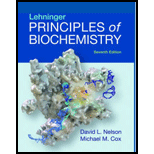
Concept explainers
(a)
To explain: The effects of DNP
Introduction:
The knowledge of the steps of respiratory chain and the pathway through which ATP (adenosine triphosphate) is produced comes from dissecting the whole process by using uncouplers and inhibitors.
(b)
To describe: The process that is directly affected by DCCD.
Introduction:
DCCD (dicyclohexylcarbodiimide) reacts with carboxyl side chains of acidic amino acids and its addition to actively respiring mitochondria decreases the consumption of oxygen and ATP production rate. Addition of DNP revert oxygen consumption; however, production of ATP remains inhibited.
(c)
To explain: Fillingame assay ATPase activity instead of ATP synthase activity.
Introduction:
The oxidative phosphorylation machinery in Escherichia coli and mammals are remarkably similar. If DCCD is added to a culture of wild-type Escherichia coli strain then further growth is blocked.
(d)
To explain: Whether DCCD-binding protein missing in mutant strain or it is just altered.
Introduction:
Fillingame selected DCCD-resistant mutant in which presence of DCCD diminishes slight amount of aerobic growth. To test whether the DCCD component is ATP synthase and or ATPase, he isolated membrane fraction from wild-type and mutant strain.
(e)
To explain: The expected result if DCCD-binding protein were in stripped membrane and if it were in soluble fraction.
Introduction:
To know DCCD-sensitive protein is an integral part of membrane or it is a part of solubilized fraction, Fillingame prepared stripped membrane and soluble ATPase using dithiothreitol.
(f)
To describe: The way through which Fillingame knew that which of the labeled proteins were of interest.
Introduction:
Fillingame exposed intact membrane of mutant and wild-type strain to
(g)
To explain: The reason behind obtaining specifically labeled same protein in wild-type fraction.
Introduction:
Fillingame exposed intact membrane of mutant and wild-type strain to
(h)
To explain: The deduction of structure, topology, and function of protein of interest.
Introduction:
On examining the protein of interest, it was found that Mr of protein of interest was about
(i)
To explain: The reason behind mutant in which serine residue is substituted with alanine is more sensitive to DCCD.
Introduction:
In later experiments, it was found that aspartate at 61 position react which DCCD. However, if serine residue in mutant strain is replaced with alanine at 21 position, then it becomes less sensitive to inhibition by DCCD more than wild-type.
(j)
To explain: The role of DCCD in oxidative phosphorylation.
Introduction:
It was found that DCCD-inhibited protein is a central part of F0F1 ATP synthase of prokaryotes, plants, and animals.
Want to see the full answer?
Check out a sample textbook solution
Chapter 19 Solutions
Lehninger Principles of Biochemistry
 BiochemistryBiochemistryISBN:9781319114671Author:Lubert Stryer, Jeremy M. Berg, John L. Tymoczko, Gregory J. Gatto Jr.Publisher:W. H. Freeman
BiochemistryBiochemistryISBN:9781319114671Author:Lubert Stryer, Jeremy M. Berg, John L. Tymoczko, Gregory J. Gatto Jr.Publisher:W. H. Freeman Lehninger Principles of BiochemistryBiochemistryISBN:9781464126116Author:David L. Nelson, Michael M. CoxPublisher:W. H. Freeman
Lehninger Principles of BiochemistryBiochemistryISBN:9781464126116Author:David L. Nelson, Michael M. CoxPublisher:W. H. Freeman Fundamentals of Biochemistry: Life at the Molecul...BiochemistryISBN:9781118918401Author:Donald Voet, Judith G. Voet, Charlotte W. PrattPublisher:WILEY
Fundamentals of Biochemistry: Life at the Molecul...BiochemistryISBN:9781118918401Author:Donald Voet, Judith G. Voet, Charlotte W. PrattPublisher:WILEY BiochemistryBiochemistryISBN:9781305961135Author:Mary K. Campbell, Shawn O. Farrell, Owen M. McDougalPublisher:Cengage Learning
BiochemistryBiochemistryISBN:9781305961135Author:Mary K. Campbell, Shawn O. Farrell, Owen M. McDougalPublisher:Cengage Learning BiochemistryBiochemistryISBN:9781305577206Author:Reginald H. Garrett, Charles M. GrishamPublisher:Cengage Learning
BiochemistryBiochemistryISBN:9781305577206Author:Reginald H. Garrett, Charles M. GrishamPublisher:Cengage Learning Fundamentals of General, Organic, and Biological ...BiochemistryISBN:9780134015187Author:John E. McMurry, David S. Ballantine, Carl A. Hoeger, Virginia E. PetersonPublisher:PEARSON
Fundamentals of General, Organic, and Biological ...BiochemistryISBN:9780134015187Author:John E. McMurry, David S. Ballantine, Carl A. Hoeger, Virginia E. PetersonPublisher:PEARSON





